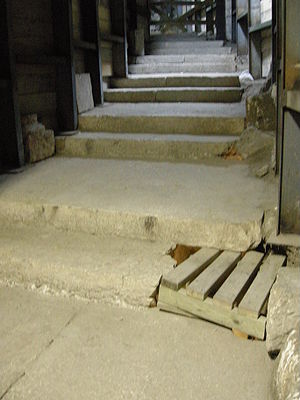- Jerusalem pilgrim road
-
Steps on the pilgrim road as they approach the Huldah Gates of the Temple.

The Jerusalem pilgrim road is an ancient road used by ritual processions ascending from the Pool of Siloam to the Temple Mount via the Hulda Gates in the Southern Wall.
History
The ancient path was improved and paved in large, well-cut stone in the pattern of two steps followed by a long landing, followed by two more steps and another landing. The road was eight meters wide and its length from the Pool to the Temple Mount is 600 meters.[1]
According to archaeologist Ronny Reich, who leads the contemporary dig uncovering the ancient road together with archaeologist Eli Shukron, pilgrims used the Pool of Siloam as a Mikveh for ritual purification before walking up the road to the Temple at Jerusalem.[1]
Sections of the ancient road were first discovered by Prof. Frederick J. Bliss and Archibald C. Dickey of the Palestine Exploration Fund between 1894 and 1897. The find was reburied when their excavation concluded. Other sections were uncovered, then reburied, by later archaeologists, Jones in 1937 and Kathleen Kenyon in 1961-1967.[2][3]
In ancient times, in the celebration called Simchat Beit HaShoeivah, water was carried up the pilgrim road from the Pool of Siloam to the Temple.
References
Categories:- New Testament places
- Hebrew Bible places
- Siloam
- Jesus and history
- Ancient sites in Jerusalem
- Classical sites in Jerusalem
- City of David
Wikimedia Foundation. 2010.


